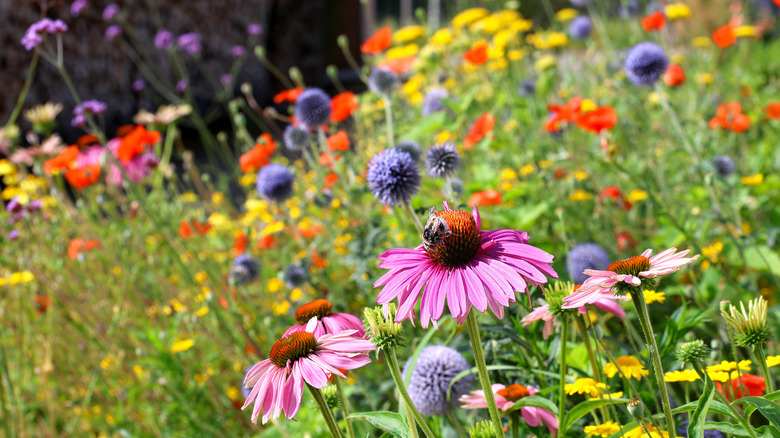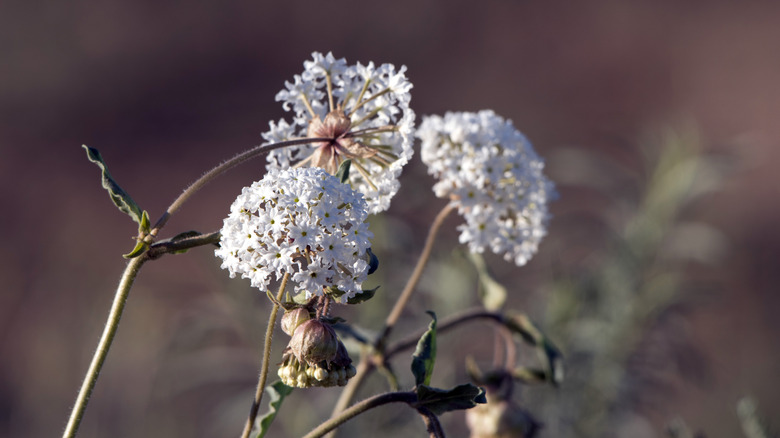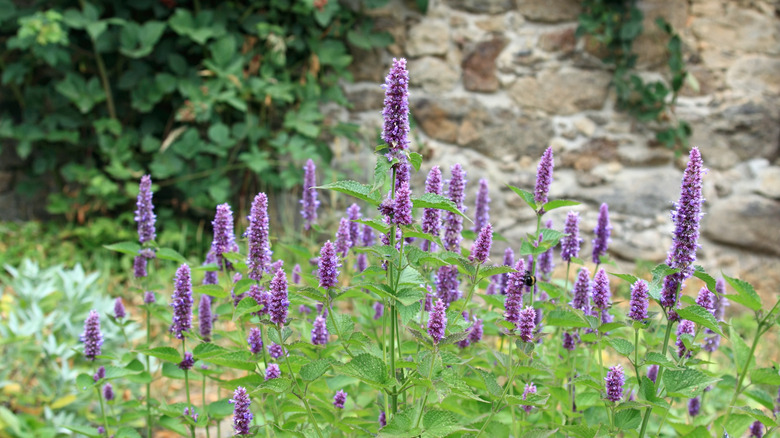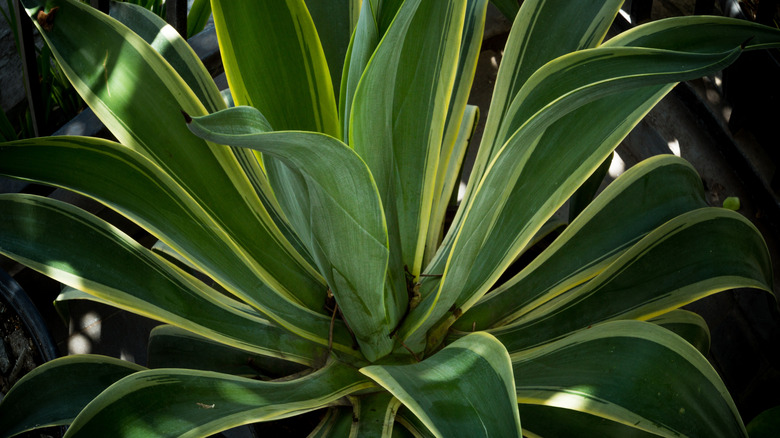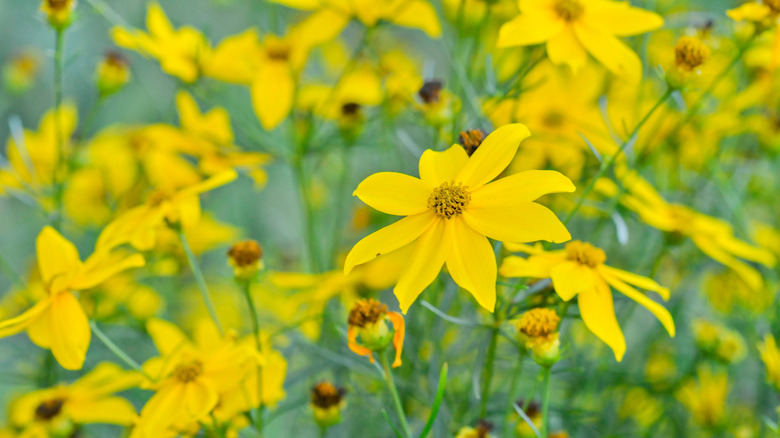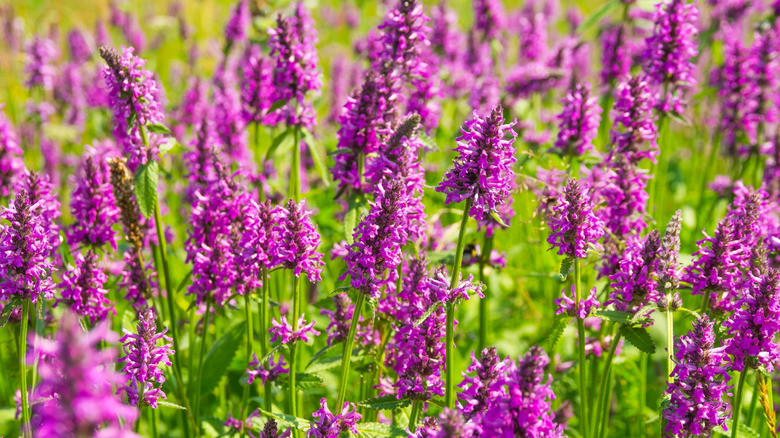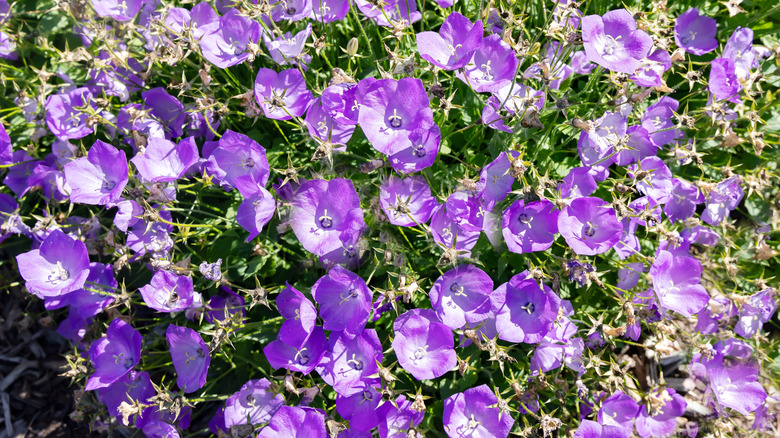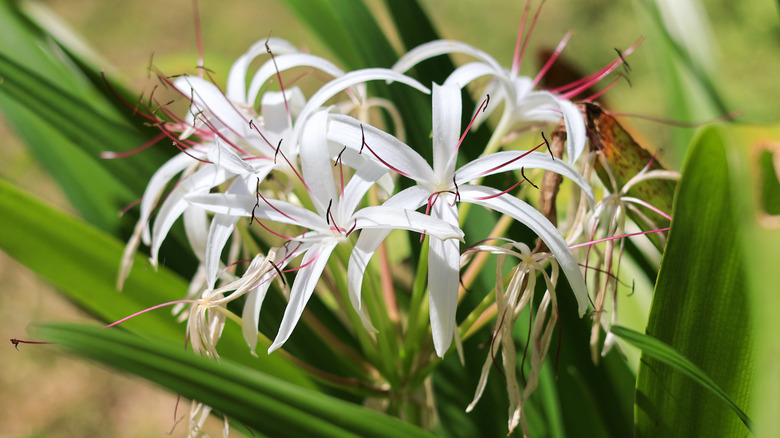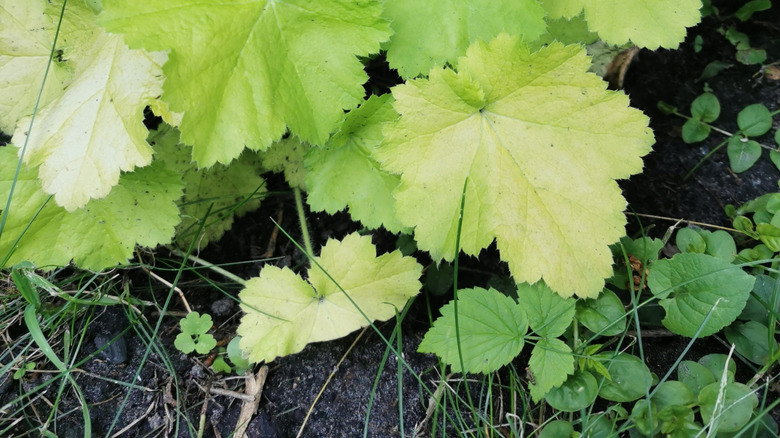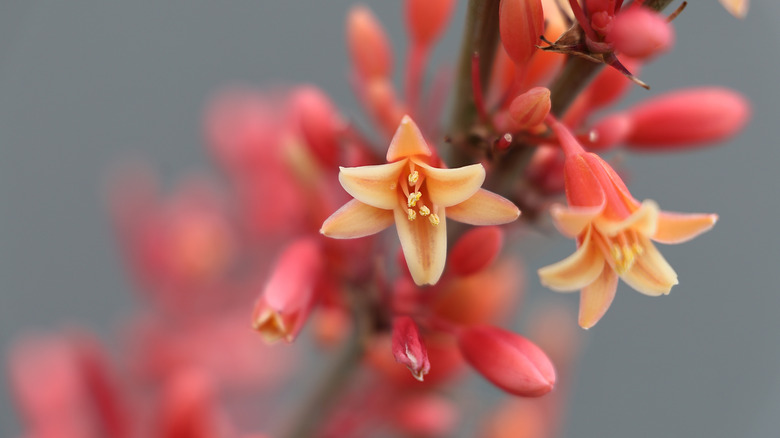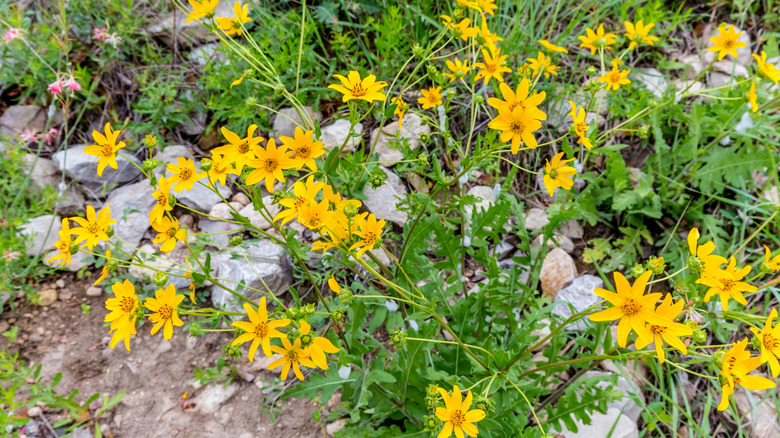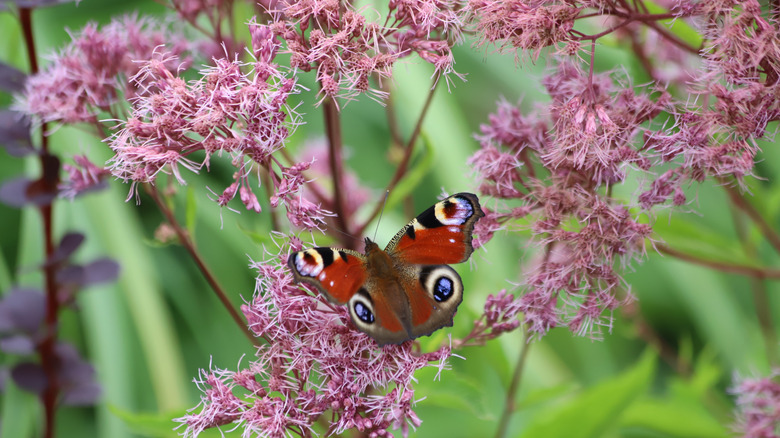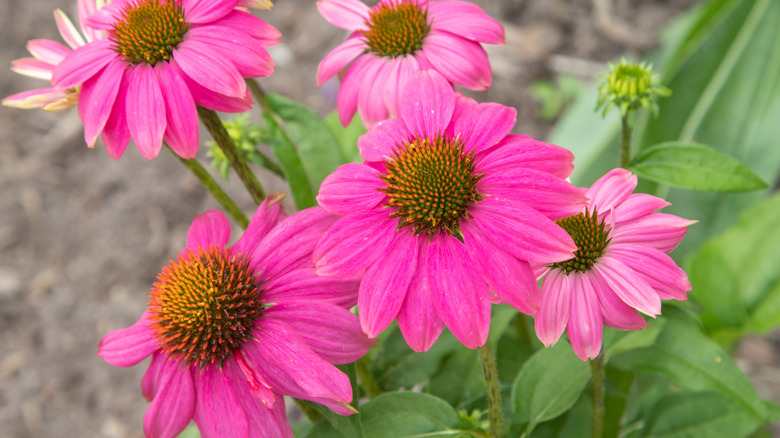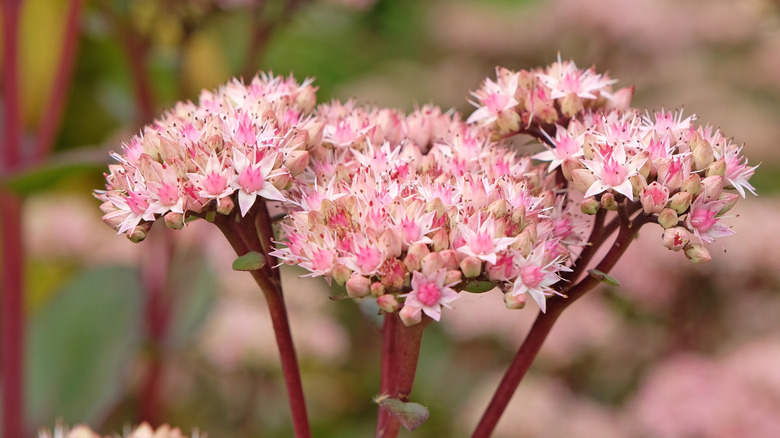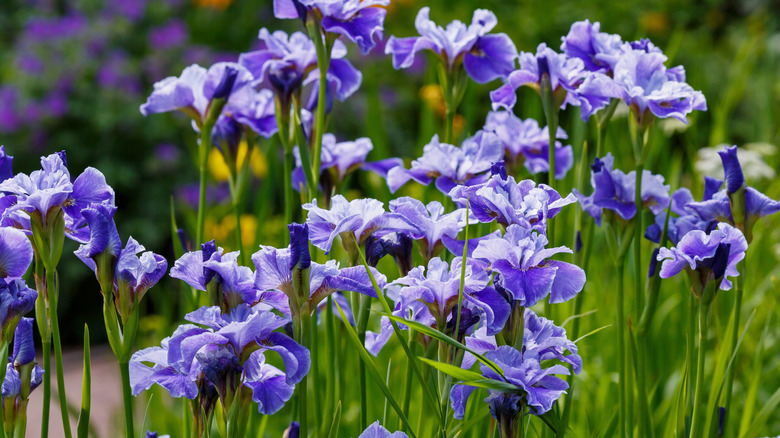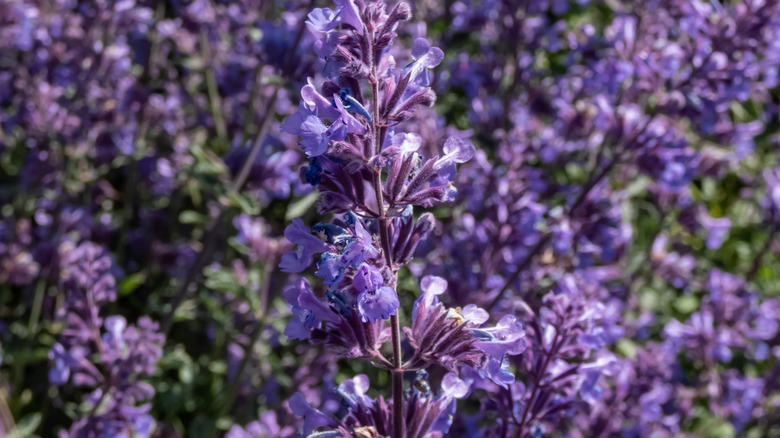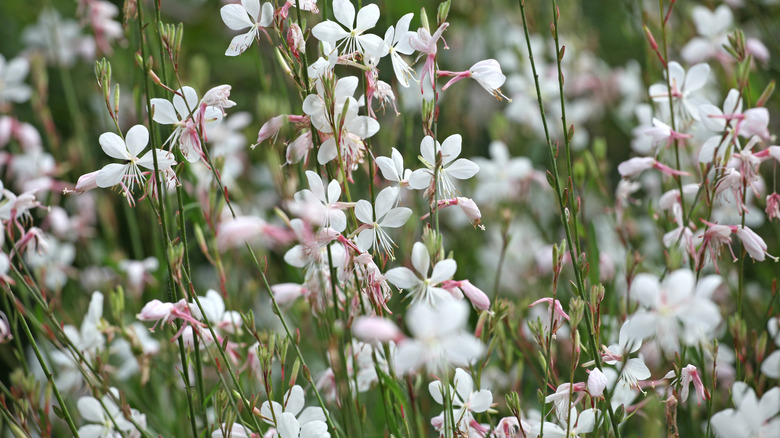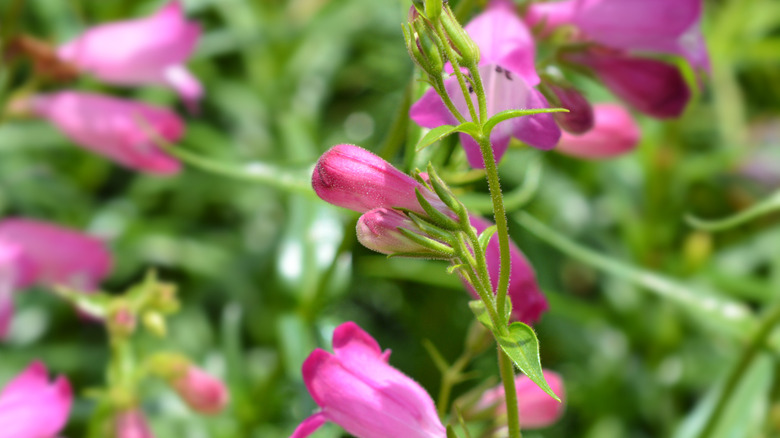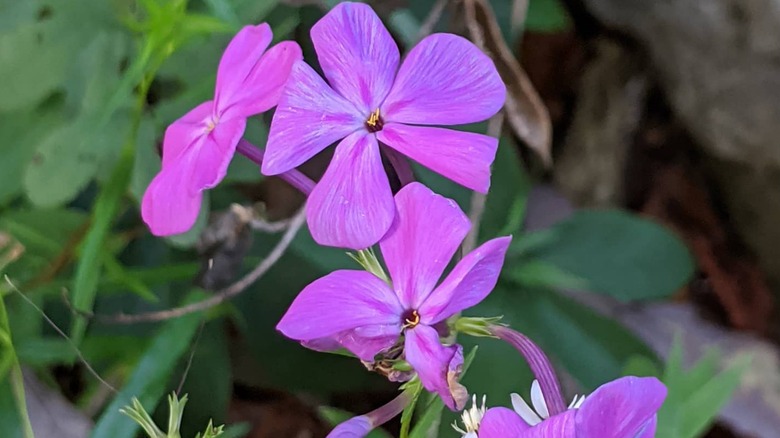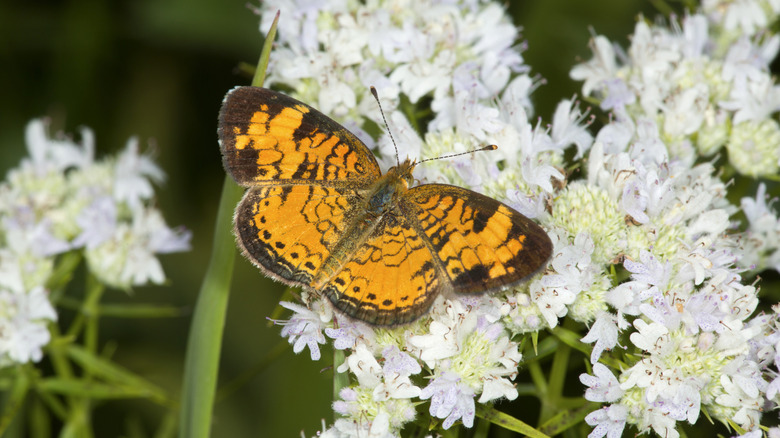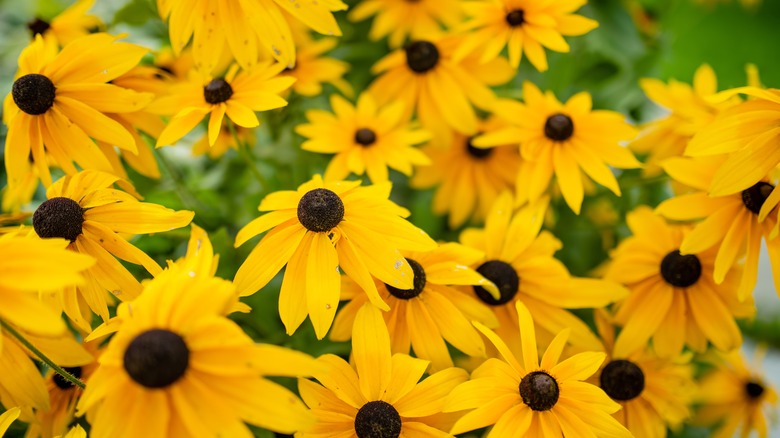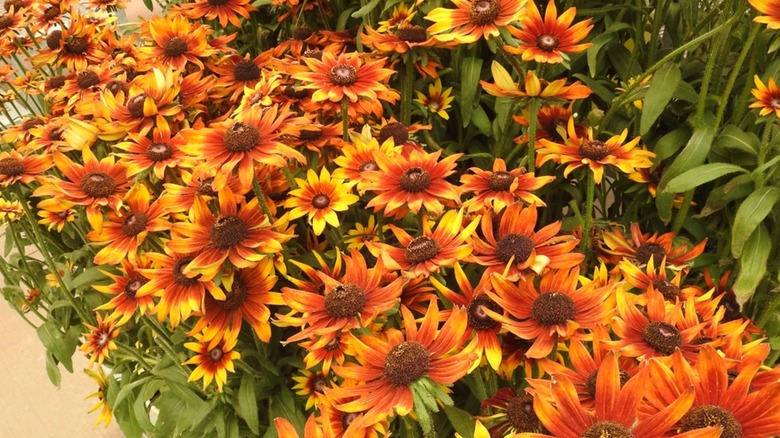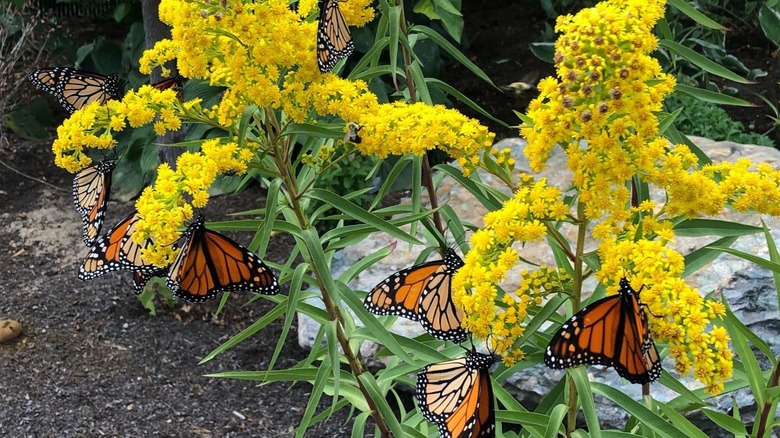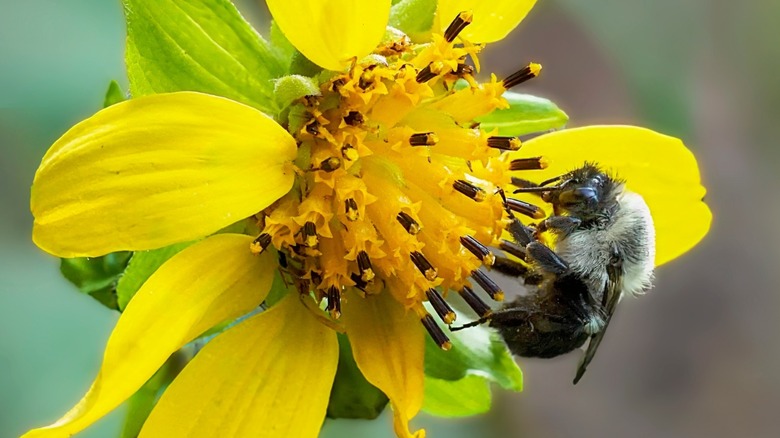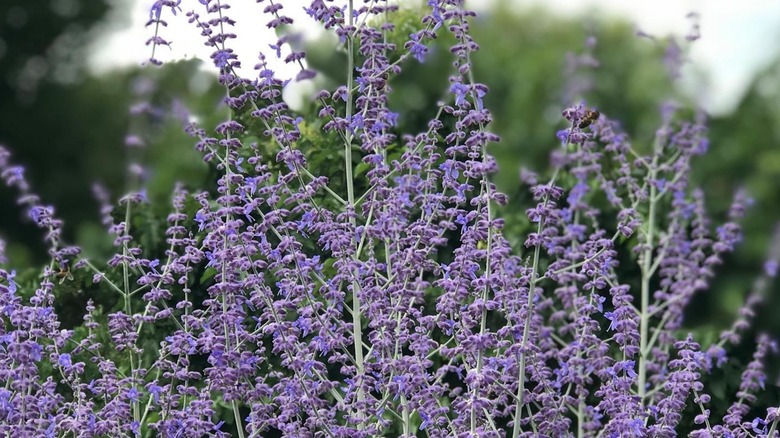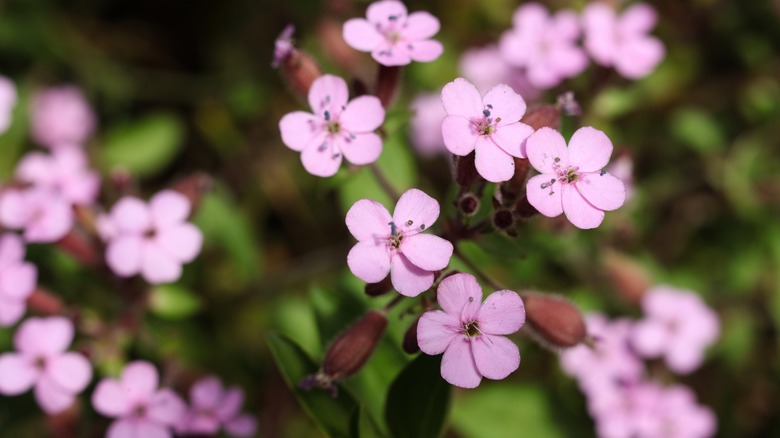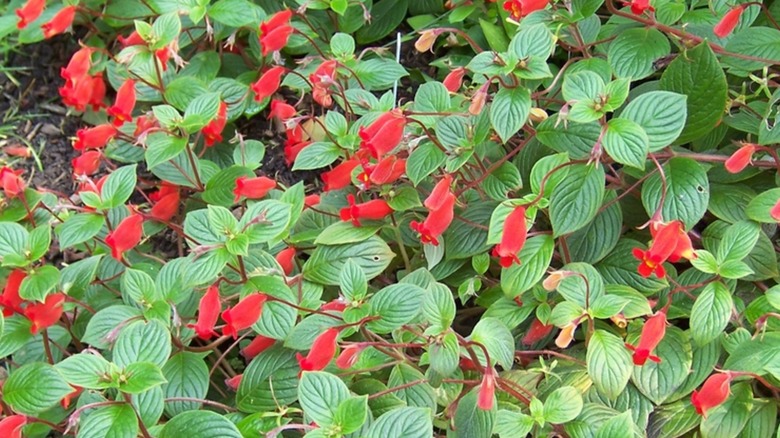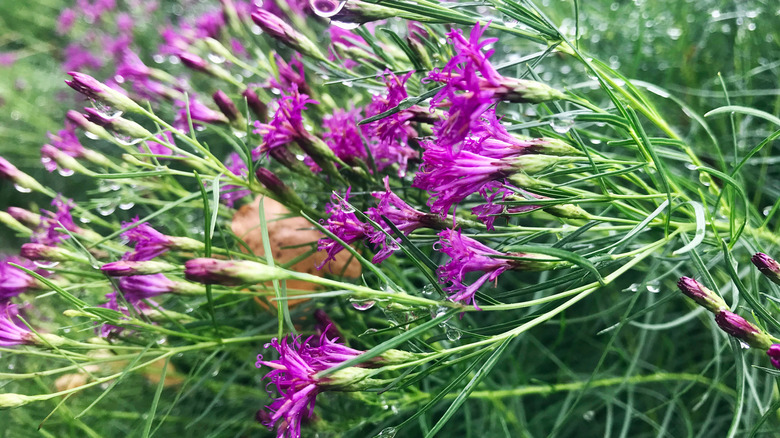Low-Maintenance Perennial Plants That Hardly Need Any Attention To Thrive
No matter where you are in your gardening journey — whether you're a complete novice, someone who's dabbled with houseplants, or an experienced gardener — the desire for a thriving outdoor space remains paramount for most of us. Unfortunately, time constraints, limited mobility, or a poor track record with plants often get in the way of reaching this goal. The increasing unpredictability of weather caused by the worsening climate crisis also contributes to these difficulties.
Luckily, there's an easy way to escape this predicament: low-maintenance perennials. Unlike annuals that can be picky about their spots and require recurring investments, some perennials return reliably every year, without expecting their growers to endlessly monitor their performance. While this doesn't imply that they don't require any attention at all – watering, staking, and mulching are key tasks to keep your plants alive — they are either better at bouncing back or highly adaptive, even when given inadequate care.
For instance, fragrant sand verbena, threadleaf tickseed, Engelmann's daisy, and Russian sage tolerate poor watering practices (which most homeowners are guilty of) or rain deficits because of their drought tolerance. Others, like American agave or Siberian iris, are easier to maintain due to their pest resistance. 'Matrona' stonecrop is brilliant at tolerating extremely hot temperatures (side-eyeing global warming). In short, there are plenty of low-maintenance perennials to fit the bill if you're serious about creating a vibrant garden. Below is a quick roundup of 27 such options.
Fragrant sand-verbena
Native to the central U.S., fragrant sand-verbena (Abronia fragrans) is a prized fragrant perennial flower that'll make your garden smell amazing without requiring much attention. From spring through fall, pink-tinged, white flowers pop up on green stems, infusing the evening air with a vanilla-like aroma and drawing in butterflies. Because these perennials, hardy in zones 7 through 10, are highly drought tolerant, they'll survive even if you don't stick to your watering schedule. The fact that they don't rank high as tasty meals for pests, nor contract many diseases, further makes them low-maintenance. Ideally, plant them in dry, sunny sites.
Anise hyssop
Whether you're blessed with loam or are working with lean, sandy soils, you can easily grow anise hyssop (Agastache foeniculum) in your partially sunny beds and borders. As their foliage emits a licorice scent, they discourage deer and rabbits from venturing closer to your ornamentals. In contrast, their summer-through-fall blooming lavender flower spikes animate your garden with bees, butterflies, and hummingbirds. Since they self-seed, planting these herbs once will ensure they return to your garden on their own each year in zones 4 through 8.
American agave
If you're looking for a fast-growing plant that can handle the heat and make your garden more unique without entailing much care, consider American agave (Agave virginica). This succulent is a trooper against dry soils and drought and thrives in shallow rocky soils, especially when they're alkaline. Pests and diseases aren't a problem, either. But because sphinx moths pollinate its fruity-smelling, gold-green blooms, you may want to choose the agave's location carefully. Tomato hornworms are the larval stage of these gorgeous moths and are a nuisance in vegetable gardens. You may grow this perennial in full-to-part sun in zones 6 through 9.
Threadleaf tickseed
Threadleaf tickseed (Anacis verticillata) may be a suitable planting choice for gardeners saddled with infertile, sandy soils because this Southeast U.S. native absolutely thrives in such conditions. In fact, in case you ever give it too much water or fertilizer, tickseed will flop down to express its disapproval. It also withstands a fair amount of drought stress, salt runoff, humidity, and herbivory. If you have time to deadhead, expect the golden daisy blooms to extend their summer display into fall and attract colorful butterflies. These low-maintenance perennials can be grown in zones 3 to 9.
Purple betony
If you want to naturalize a small patch, edge a border, or adorn your walkways with flamboyant containers, purple betony (Betonica officinalis) is the low-maintenance perennial you should seek. This slow-growing edible stays under 2 feet up and across. It also features a unique design, where a flower stalk supports an alternating mix of leaves and purple flowers that bees and butterflies find particularly attractive. You can grow this drought-resistant plant in most soils, including sand and clay, provided they drain well or remain wet only occasionally. Start purple betony with seeds in zones 4 to 8.
Carpathian bellflower
Unfussy about the soil's pH levels, Carpathian bellflowers (Campanula carpatica) are the perennials to plant if you live in USDA zones 3 to 8. Starting in spring, these low growers burst into a mass of blue, purple, or pink (depending on the cultivar) flowers that sway atop green foliage well into summer. While luring hummingbirds in, they still manage to deflect the attention of deer and rabbits. Carpathian bellflowers only grow about 1 foot tall and can be utilized as easy-maintenance groundcovers. However, you'll need to water them and mulch their beds during dry conditions.
Southern swamp lily
Also known as string lily, southern swamp lily (Crinum americanum) is an easy-maintenance bulb for boggy areas. Grown as a perennial in zones 8 through 11, the southern swamp lily can tolerate standing water to a depth of 12 inches. However, even if you don't have a wet site around, you can still grow this moisture-lover in acidic, clay soils with mulch for winter protection. In bloom, the pleasantly fragrant, pink-blushed, white flowers attract moths. They truly want to be left alone, as any movement or transplantation can delay flowering by three years.
'Pretty Pistachio' coral bells
Optimal in moderately shaded sites, though they tolerate heavy shade just as well, 'Pretty Pistachio' coral bells (Heuchera 'Pretty Pistachio') are another low-maintenance perennial that thrives even when neglected. Staying under 1 foot, though spreading twice as wide, these evergreen perennials look best planted in mass, where you may enjoy the butterflies and hummingbirds clamoring for their pink flowers. Alternatively, place these low-growers in borders to benefit from their salt or deer resistance. Although hardy in zones 4 through 9, spread mulch in cold winters so the roots stay put in the soil.
Red yucca
Red yucca (Hesperaloe parviflora) is the low-maintenance, native red flower you should be using to attract hummingbirds to your yard if you live in zones 6 to 10. This spineless, thread-leaved perennial is a tough plant that can tolerate urban pollution, salt, heat, and drought. With full sun, it can root itself in most soils, including calcite, loam, and sand. However, it draws the line at heavy or clay soils, as slow water infiltration makes it susceptible to rot. You may want to avoid growing this plant if deer are a problem in your area.
Engelmann's daisy
Native to various regions in the central U.S., Engelmann's daisy (Engelmannia peristenia) is a gorgeous wildflower worth consideration if you keep a busy schedule. The yellow petals unfurl late in the afternoon and stay open until it gets too hot for them the next day, though not without delighting bees and butterflies. If you spend time trimming their foliage in the summer, you can prolong the blooms into fall. They can tolerate heat and drought in zones 5 to 10 and adapt to all soils, including infertile ones, with full sun exposure. Given their deep taproots, use them to control runoff on slopes.
Hollow Joe pye weed
In zones 4 to 8, where moist soils are amply present, you may utilize hollow Joe pye weed (Eutrochium fistulosum) as an easy-care perennial to deck your garden. Producing vanilla-smelling, pink flowers from summer through frost, hollow Joe pye weed enlivens the area through the scores of pollinators that visit its flowers, or the birds that flock in later for seeds. Deer, thankfully, care little about this fire-resistant perennial. For the best performance, plant these pollinator magnets in full sun — if not, be sure to deploy understory plantings in shaded areas so their foliage receives support to remain upright.
'PowWow Wild Berry' coneflower
'PowWow Wild Berry' coneflower (Echinacea purpurea 'PowWow Wild Berry') is a low-maintenance variety of coneflower you can grow from seed for a budget-friendly garden in zones 3 to 9. In mid-summer, rosy pink flowerheads adorn the dark green leaves, and continue to do so into mid-fall, without requiring any deadheading! Soon after, seeds follow that finches devour as long as they persist on the herbaceous perennial. These coneflowers grow in full or part sun exposure on well-draining soils. Resistant to rot, you may have to avoid them if your area falls in the range of Japanese beetles or has a history of aster yellows disease.
'Matrona' stonecrop
A sturdy plant that grows fast, takes heat, and toughs it out in rocky terrains? Meet 'Matrona' stonecrop (Hylotelephium 'Matrona'). In a short while, it extends nearly 30 inches wide and equally tall, and can be effectively used as a groundcover. From summer through fall, it's laced in pink, broccoli-shaped flowerheads that change into bronze for winter. 'Matrona' can be successfully grown in zones 3 through 9 in neutral or alkaline soils exposed to full sun. It's highly drought-tolerant and is rarely browsed by deer or rabbits. You'll need to ensure the soils remain dry, or slugs may become problematic.
Siberian iris
Bedeck the area surrounding your water sources with easy-grow perennials like Siberian iris (Iris sibirica). These thrive in constantly moist conditions — bonus if they're mildly acidic and humusy. Since they require cold exposure to produce blooms, they're best planted in the fall for a head start and are hardy in zones 3 to 8. As shade tends to lower bloom quality, they're best grown in full sun sites, though you may site them underneath black walnut trees to benefit from their juglone tolerance. Pests and diseases aren't common, but you'll need to be gloved while handling the plant to avoid contact dermatitis.
'Walker's Low' catmint
Sporting a full head of aromatic, silvery-green leaves that deer don't bother with makes 'Walker's Low' catmint (Nepeta x faassenii 'Walker's Low') an excellent planting option — the easy care is a bonus. It's largely unaffected by pests or diseases. Plus, it's tolerant of pollution, drought, and dry soils and exhibits neutrality to soil pH levels. Waves of lavender-blue flowers that bring in hummingbirds, butterflies, and bees from spring through fall add a nice touch to any garden. Plant in full sun in zones 4 to 8, though you may need to offer afternoon shade in the southern ranges.
White gaura
Add an airy touch to your garden with white gaura (Oenothera lindheimeri). Around summer, it sprouts wiry stems atop which pink buds unfold into sprays of white blooms, drawing the attention of bumblebees and butterflies. Since it can grow 5 feet high and can't support the weight of its stems as it grows older, interplant shorter ornamentals for support. Otherwise, stick to shorter cultivars, like 'Belleza Dark Pink.' The thick taproots on white gaura give it good drought tolerance. Slightly acidic, moist, average soils in zones 5 through 9 are ideal for growth.
'Red Rocks' penstemon
Despite the name, 'Red Rocks' penstemon (Penstemon x mexicali 'Red Rocks') actually produces rosy pink flowers — nonstop — all summer long, though the show may extend through the first frost if deadheaded. Curiously, these herbaceous perennials perform their best in disturbed soils, so newly constructed sites or recently aerated yards are optimal locations. In zones 4b to 8, they can be grown in clay, sand, or lean soils with full sun exposure, though light shade is tolerated. Avoid growing them in areas receiving winter rain, as you'll need to monitor them for rot. If you deer-proof them, they can reach 3 feet high.
'Wanda' phlox
The dainty blooms of 'Wanda' phlox (Phlox 'Wanda') hold a magnanimous pull on its onlookers, making it deserving of a spot in its adaptive range of zones 5 to 10. Depending on the sun exposure, 'Wanda' produces fuchsia or magenta flowers in mid-spring, and continuously through frost to the utter delight of the local butterflies. Since 'Wanda' can self-seed, you may want to tuck it in a small, informal patch or containers. It can tolerate humidity, yet you may need to monitor the growth for powdery mildew, rust, or cankers every now and then.
Mountain mint
Well-adapted to zones 4 through 8, mountain mint (Pycnanthemum tenuifolium) is another fast-growing, low-maintenance perennial worth planting. Summer-into-fall blooming white and lilac flowers support the local bees and butterflies. When crushed, the leaves release a minty aroma, which surprisingly can ward off mosquitoes. So, if these pesky bugs start attacking your shins on your garden walk, you know what to do. As mountain mint is an assertive spreader, site it along walkways or hard elements to cordon off its boundaries. Well-draining, acidic soils exposed to full sun or partial shade are favored. Use in rain gardens to check erosion.
Orange coneflower
Save for soggy substrates, black-eyed Susan or orange coneflower (Rudbeckia fulgida) can be conveniently grown in any soil in zones 3 to 9. The brown-eyed, orange-rayed blooms make their first appearance in August, coming into the notice of butterflies, and repeat the performance through October. Orange coneflowers can grow 3 feet tall and be placed in borders for some deer proofing. Alternatively, use them as specimens in rain or cottage gardens, allowing them to naturalize the area, assuming finches don't wolf down all the seeds. Select disease-resistant cultivars like 'Goldsturm' or 'Little Goldstar' for even lower maintenance.
'Summerina Yellow' Echibeckia
Hybridized from black-eyed Susan and coneflowers, 'Summerina Yellow' Echibeckia (Rudbeckia x Echinacea 'Summerina Yellow') displays the best features of both plants, starting with fast growth, long-lasting blooms, and strong disease resilience. 3-inch wide, red-blushed, yellow flowers appear in summer and last through mid-fall, attracting pollinators. Plus, they've a compact size that doesn't grow beyond 2 feet in either direction, making it easier to tuck these perennials in small spaces or patio containers. At home in zones 6 through 10, these drought-resistant beauties tolerate all soil textures, provided they drain well. You may need to offer supplemental irrigation during hot weather.
Seaside goldenrod
In coastal gardens where salt tolerance is an absolute necessity, consider growing seaside goldenrod (Solidago sempervirens) because it'll thrive in such conditions. Alternatively, pop this native wildflower in water gardens because it adapts well to wet soils. Seaside goldenrod doesn't require fertilization and is usually unaffected by pests and diseases. To top it all, it blooms continually from August to November, catering to a myriad of specialized bees, butterflies, and birds. Since it doesn't produce suckers, it remains within the reams of its ordained boundaries. Zones 3 to 8 are its ideal range with full sun exposure.
Bear's foot
A low-maintenance perennial that also helps you contribute to arresting the decline in the bee population? Say hello to bear's foot (Smallanthus uvedalia). Prominent in the natural areas of the central and eastern U.S., bees use bear's foot hollow stalks as an overwintering habitat. Plus, butterflies and birds cling to their summer blooms and seeds. Bear's foot has a fast growth rate but doesn't grow weedy. Plonk it back in the borders to add height — it can grow 8 feet tall and may need stake support. Drought-resistant, it grows well in zones 6 through 9.
Russian sage
Take your garden's sensory feel up a notch with Russian sage (Salvia yangii). The tall spikes covered in lavender blooms will add an airy texture to the area while simultaneously infusing it with a sharp aroma. As the summer blooms extend into fall, expect butterflies and hummingbirds to stay as long. Russian sage enjoys full sun exposure and is ideal for arid sites where its drought tolerance comes in handy. Fortunately, it isn't too hung up on pH or fertility levels, and grows well in zones 5 through 9. You may have to shear its foliage after a hard frost for a tidy appearance.
Rock soapwort
Rock soapwort (Saponaria ocymoides), also known as tumbling Ted, is a low-growing perennial that can be utilized as a groundcover, provided there isn't much pedestrian traffic, or trained over retaining walls. A minimum of six hours of direct light exposure is a must. Tolerance for low fertility and drought makes it suitable for sandy soils. Purplish-pink flowers cover the plant during spring and summer, while the tear-shaped foliage maintains interest through the winter without drawing the attention of deer. You can grow rock soapwort in zones 2 through 9, though it may not perform as well in winter rains or extremely humid conditions.
'Evita' hardy gloxinia
For shade gardens or underneath tall trees, consider adding 'Evita' hardy gloxinia (Seemannia nematanthodes 'Evita') as an easy maintenance option. Hardy in zones 8 to 10, 'Evita' is sure to make your beds pop with its reddish-orange petals that continually appear all summer long until they're frost-killed. Unsurprisingly, they catch the fancy of hummingbirds. As these perennials don't grow taller than 1 foot but spread four times as wide, use them as groundcovers or around walkways. They handle humidity surprisingly well. The only downside is that they go dormant in the winter and can be slow to green up in spring.
'Iron Butterfly' ironweed
'Iron Butterfly' ironweed (Vernonia lettermannii 'Iron Butterfly') is a cultivar bred from a native plant that can be grown in zones 4 to 9. If you do, expect lavender blooms and their paramours (like butterflies and bees) to add attractive color toward the tail end of summer when everything else is fading or gone dormant. Even after terminating blooms, 'Iron Butterfly' appeals to gardeners with its frilly leaves. It adapts to all soil textures and pH levels, but avoid growing it in rich soils where its growth will become lanky. It can withstand dry and drought conditions after establishment.
